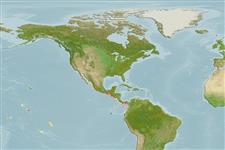Pelagothuria natatrix Ludwig, 1893
| Native range | All suitable habitat | Point map | Year 2050 |

|
| This map was computer-generated and has not yet been reviewed. |
| Pelagothuria natatrix AquaMaps Data sources: GBIF OBIS |
Upload your photos
Google image |
No photo available for this species.No drawings available for Pelagothuriidae.
Google image |
No photo available for this species.
Classification / Names Common names | Synonyms | CoL | ITIS | WoRMS
Holothuroidea | Elasipodida | Pelagothuriidae
Environment: milieu / climate zone / depth range / distribution range Ecology
Pelagic; depth range 0 - 4505 m (Ref. 127484). Tropical
Distribution Countries | FAO areas | Ecosystems | Occurrences | Introductions
Eastern Pacific.
Length at first maturity / Size / Weight / Age
Maturity: Lm ? range ? - ? cm
Short description Morphology
Shape is a reminiscent of a medusa that resembles a jellyfish. Body conical, which supports an enormous umbrella-like veil. The veil extended anteriorly, composed of 12-16 large webbed podia. Body wall transparent and pigmented pale violet or pink.
Only known truly pelagic holothurian, floating or drifting near seafloor or high in the water column (Refs. 109722, 129602). Also known as a swimmng sea cucumber, it is found in low oxygen areas and is assumed as a tactic to avoid predators that are more oxygen-hungry and could easily suffocate (Ref. 127487). Feeds on resuspended sediments or detrital material from shallower depths (Ref. 109722).
Life cycle and mating behavior Maturity | Reproduction | Spawning | Eggs | Fecundity | Larvae
Members of the class Holothuroidea are gonochoric and have only one gonad. Spawning and fertilization are both external and some exhibit brooding. Life cycle: Embryos develop into planktotrophic larvae (auricularia) then into doliolaria (barrel-shaped stage) which later metamorphose into juvenile sea cucumbers.
Main reference
References | Coordinator | Collaborators
Alvarado, J.J. and J. Cortés. 2009. (Ref. 83942)
IUCN Red List Status (Ref. 130435)
CITES status (Ref. 108899)
Not Evaluated
CMS (Ref. 116361)
Not Evaluated
Threat to humans
Harmless
Human uses
| FishSource |
Tools
More information
Internet sources
BHL | BOLD Systems | CISTI | DiscoverLife | FAO(Publication : search) | Fishipedia | GenBank (genome, nucleotide) | GloBI | Gomexsi | Google Books | Google Scholar | Google | PubMed | Tree of Life | Wikipedia (Go, Search) | Zoological Record
Estimates based on models
Preferred temperature
(Ref. 115969): 12.6 - 16.8, mean 14.8 (based on 30 cells).


